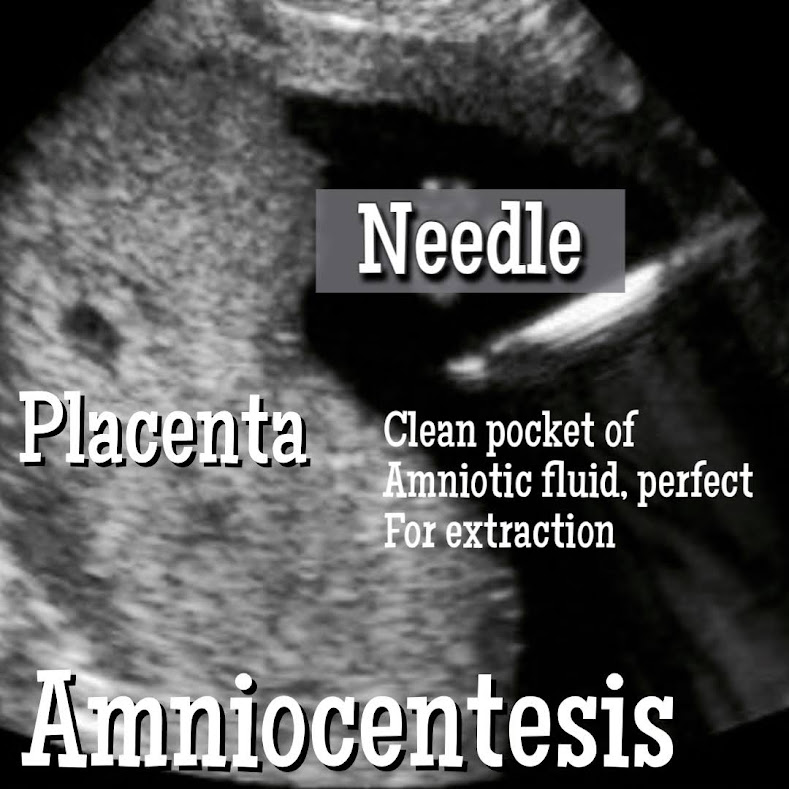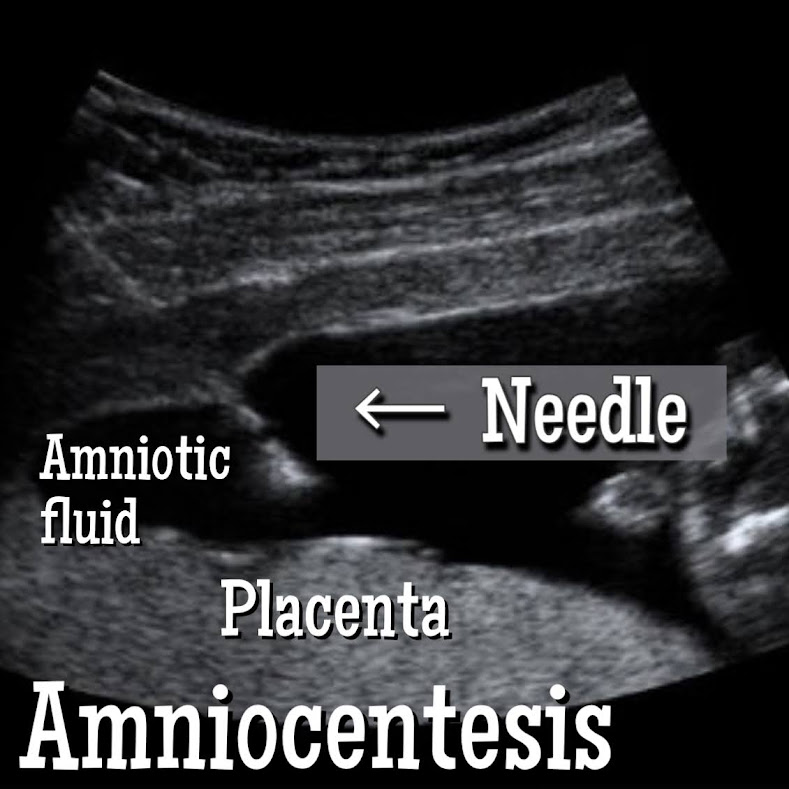Amniocentesis is a diagnostic test done during pregnancy to rule out genetic or chromosomal diseases, it is performed in the event that the results of your triple genetic test come back abnormal. If you are looking for information about an Amniocentesis keep reading, because this article is going to answer a lot of questions you may have about the procedure, also I’ll give the advantages and disadvantages of an amniocentesis. You’ll also see ultrasound images of the procedure in this article. Ready? Let’s begin.
Amniocentesis, here is what you need to know.
How does the amniocentesis procedure work?
Amniocentesis is done under ultrasound guidance to find a safest, largest and deepest pocket of amniotic fluid, free of baby body parts or placenta for the needle to enter the amniotic sac, so a sample of amniotic fluid can be safely extracted through that needle to a syringe. Once the safe location has been determined with the ultrasound, the fluid can be removed. The entire process takes roughly half an hour, while the collection of fluid takes significantly less time, approximately 5 minutes perhaps less.
The amniotic fluid, which includes cells that have been shed by the fetus, is taken to the laboratory so that it may be examined. The return of results can take anything from a few days to a couple of weeks, depending on the circumstances and/or the laboratory.
Here are specific steps of the procedure:
- Ultrasound Evaluation: Before the procedure begins, ultrasound is used to determine viability of the procedure and various factors such as fetal position, movements, amount of the amniotic fluid to determine the safest largest and deepest pocket of fluid, free of baby body parts or placenta, etc. Once this first evaluation takes place, and the site of the puncture has been determined we proceed to step #2.
- Preparation: The abdomen is cleaned with antiseptic where the needle is to be inserted. The tools are coated with heparin to prevent clotting. The measures are essential for avoiding the risk of infection due to external factors.
- Needle Insertion: Once the patient is ready, a needle is inserted through the abdomen and walls of the uterus into the amniotic sac with ultrasound guidance and a small amount of amniotic fluid is collected. The area chosen to insert the needle is ensured to be away from the fetus.
- Post procedure: After the procedure, the patient is advised to take rest for the initial 24-hours post procedure avoiding any stressful or heavy-duty work; normal activities are however allowed later on.
Images of an Amniocentesis.


When is an amniocentesis typically carried out?
Typically, an amniocentesis will be conducted between the ages of 14 and 20 weeks. Amniocentesis can be performed at some medical facilities as early as 11 weeks into a pregnancy.
For a variety of reasons, amniocentesis may be performed later in the third trimester of pregnancy. If your membranes have burst before they were supposed to, your healthcare practitioner may suggest that you have the procedure so that they may check for uterine infections. In babies who have Rh disorder, an amniocentesis can also help evaluate the severity of fetal anemia, which in turn can assist your doctor in determining whether or not the fetus needs potentially life-saving blood transfusions.
The development of the lungs is sometimes evaluated via amniocentesis. If that is the case, it is done not long before the delivery.
What are we looking for, when we do the amniocentesis test?
Chromosomal abnormalities, neural tube anomalies, and other genetic problems can be detected during amniocentesis. The most prevalent form of chromosomal abnormalities is known as Down syndrome or trisomy 21. Genetic disorders encompass a wide range of conditions, including cystic fibrosis. Spina bifida is the neural tube defect that affects the most people.
In the later stages of pregnancy, an amniocentesis may be performed in order to determine whether or not the lungs of the unborn child are developed sufficiently to allow the child to breathe on his or her own.
An additional benefit of amniocentesis is that it makes it possible to obtain DNA for paternity testing prior to birth. During an amniocentesis, a sample of the putative father’s DNA is obtained and compared to the sample of the baby’s DNA that has been obtained. When it comes to establishing paternity, these results are extremely reliable (99 percent).
What do the results of the amniocentesis indicate?
An amniocentesis is a type of diagnostic technique that can detect chromosome abnormalities, neural tube anomalies, and genetic illnesses with a high degree of accuracy (98-99 percent). The severity of certain birth anomalies cannot be determined by this test, despite the great probability that it will correctly identify the condition. The levels of alpha-fetoprotein and more advanced levels of ultrasounds can be helpful in determining the severity of any potential handicap that may be present.
What are the potential dangers and adverse consequences that this could have on the mother or the baby?
Although amniocentesis is generally a risk-free technique, it is well acknowledged that it is an invasive diagnostic examination that does carry the possibility of adverse outcomes. Despite the risks, this test is widely done and is usually very safe. The most significant danger associated with amniocentesis is the possibility of a miscarriage, fetal demise or preterm labor later in pregnancy.
The chance of having a miscarriage range from one in two hundred to one in four hundred. The possibility of having a miscarriage can be due to an infection in the uterus, the leaking of the amniotic sac, or the premature induction of labor.
It is possible for the fetus to come into contact with the needle, however this occurrence is extremely unlikely. The needle is guided away from the baby with the help of a sonogram, which is one of the many safety measures that are done. When the needle first penetrates the skin of the mother, she may feel a sharp pain, and then again when it enters the uterus, she may feel another intense pain.
After the completion of the treatment, the mother is at risk of experiencing additional adverse effects, which may include the following:
- Cramping.
- Fluid leakage.
- Mild discomfort in the area surrounding the puncture.
Please get in touch with your primary care physician if any of these issues persist or worsen.
Share the post.

What are the benefits and drawbacks of getting tested?
The decision to be tested or not depends on a variety of factors that differ from person to person and couple to couple. After completing the tests and establishing the diagnosis, you will be presented with the following opportunities.
- Investigate any possible interventions that could be available (i.e., fetal surgery for spina bifida).
- Start making preparations now for a child with special requirements.
- Start preparing for the expected changes in your lifestyle.
- Identify support groups and resources.
There are a variety of reasons why certain parents or couples can make the decision to opt out of further testing.
- They are content with the results, despite the fact that there is no certainty on the outcome.
- Making a choice regarding whether or not to bring the pregnancy to term is not an option for the mother due to personal, moral, or religious considerations.
- Some parents decide not to subject their developing child to any kind of testing that carries even the slightest possibility of causing harm to the child.
It is essential to have an in-depth conversation with your healthcare physician about the potential downsides and upsides of testing. Your healthcare professional will assist you in determining if the potential benefits of the outcomes potentially outweigh any dangers that may be associated with the operation. It is also recommended to research as well to make an informed decision.
So, summarizing What are the Advantages and Disadvantages of Amniocentesis?
Amniocentesis has both positive and negative aspects to consider. Therefore, in this segment of the article we are talking about the specific Advantages and Disadvantages of Amniocentesis?
Advantages or benefits of an Amniocentesis.
- This method assists the parents in establishing the overall health of their unborn child and enables them to make appropriate preparations for any potential difficulties or unforeseen events.
- This method has been demonstrated to be one of the most effective approaches to the practice of genetic diagnostics. It has been utilized for the purpose of successfully identifying abnormalities such as Down Syndrome, Fragile X, Neural Tube Defects, Edwards Syndrome, Turner Syndrome, and other similar conditions.
- It has also been shown to be beneficial in detecting hereditary illnesses including Tay-Sachs disease, Sickle cell anemia, Hemophilia, and other similar conditions.
Disadvantages of an Amniocentesis due to the Risk of Complications.
- It is imperative that the procedure be carried out at the specified time frame, which is between the 14th and 16th week of a woman’s pregnancy. If performed before this time period, the procedure could result in fatal harm to either the mother or the unborn child.
- There is always a risk factor of infection being involved, and if adequate equipment and proper sterile mediums to disinfect the tools are not employed, then the situation of fatal infections may occur. There is always a risk factor of infection being involved.
- In addition, there is a possibility of premature labor and delivery, and in the most severe cases, an abortion, when complications from amniocentesis are present.
- Due to the fact that this method is able to determine the gender of the developing fetus, it is quite likely that an ethical dilemma will occur in the event that a set of parents decides to have an abortion for the purpose of gender discrimination.
Looking for more helpful information about pregnancy? Check any link below.
How to Relieve Stress During Pregnancy.
Leg Cramps During Pregnancy: What to Do.
How to Get Rid of Round Ligament Pain During Pregnancy.
Information about Spina Bifida ultrasound.
Final thoughts about Amniocentesis.
To a pregnant woman, the words “test” or “procedure” can strike fear in their hearts. Have faith that there are others in your situation. However, it can be quite helpful to understand the reasoning behind recommendations and the process for having these tests done. I hope this information was helpful to some of you, don’t hesitate to leave a comment or send a message if you have any other questions.
Zadi, xo
Disclaimer: The medical information on this post is for informational, educational and entertainment use only. Under no circumstances, this information is to replace your doctor’s advice or to treat any disease. For proper care, always visit your doctor. Ultrasoundfeminsider is not liable for any injury caused for reading this article.










I have been absent for a while, but now I remember why I used to love this website. Thanks, I will try and check back more often. How frequently you update your site?
Hi there, I love to hear that you love my site. I update my blog with new article and good info every single week.